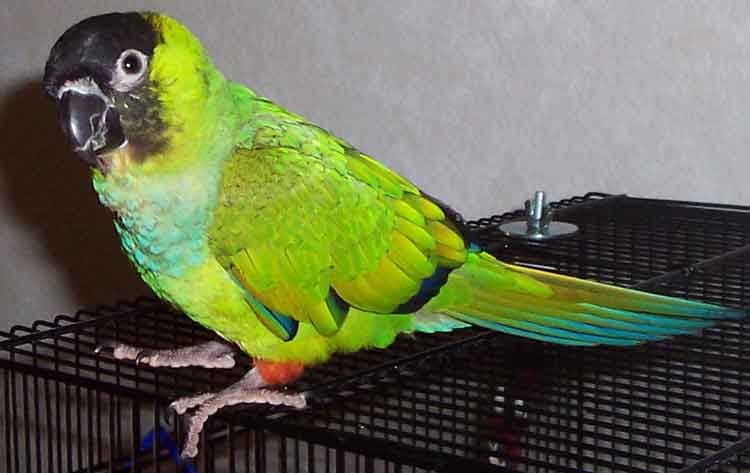
Aratinga nenday (*)
Superregnum: Eukaryota
Cladus: Unikonta
Cladus: Opisthokonta
Cladus: Holozoa
Regnum: Animalia
Subregnum: Eumetazoa
Cladus: Bilateria
Cladus: Nephrozoa
Superphylum: Deuterostomia
Phylum: Chordata
Subphylum: Vertebrata
Infraphylum: Gnathostomata
Megaclassis: Osteichthyes
Cladus: Sarcopterygii
Cladus: Rhipidistia
Cladus: Tetrapodomorpha
Cladus: Eotetrapodiformes
Cladus: Elpistostegalia
Superclassis: Tetrapoda
Cladus: Reptiliomorpha
Cladus: Amniota
Classis: Reptilia
Cladus: Eureptilia
Cladus: Romeriida
Subclassis: Diapsida
Cladus: Sauria
Infraclassis: Archosauromorpha
Cladus: Crurotarsi
Divisio: Archosauria
Cladus: Avemetatarsalia
Cladus: Ornithodira
Subtaxon: Dinosauromorpha
Cladus: Dinosauriformes
Cladus: Dracohors
Cladus: Dinosauria
Ordo: Saurischia
Cladus: Eusaurischia
Subordo: Theropoda
Cladus: Neotheropoda
Cladus: Averostra
Cladus: Tetanurae
Cladus: Avetheropoda
Cladus: Coelurosauria
Cladus: Tyrannoraptora
Cladus: Maniraptoromorpha
Cladus: Maniraptoriformes
Cladus: Maniraptora
Cladus: Pennaraptora
Cladus: Paraves
Cladus: Eumaniraptora
Cladus: Avialae
Infraclassis: Aves
Cladus: Euavialae
Cladus: Avebrevicauda
Cladus: Pygostylia
Cladus: Ornithothoraces
Cladus: Ornithuromorpha
Cladus: Carinatae
Parvclassis: Neornithes
Cohors: Neognathae
Cladus: Neoaves
Cladus: Telluraves
Cladus: Australaves
Ordo: Psittaciformes
Familia: Psittacidae
Subfamilia: Arinae
Tribus: Arini
Genus: Aratinga
Species: Aratinga nenday
Name
Aratinga nenday (Vieillot, 1823)
Synonyms
Psittacus nenday (protonym)
Nandayus nenday (Vieillot, 1823)
References
Primary references
Bonnaterre, P.J. & Vieillot, L.J.P. 1823. Tableau encyclopédique et méthodique des trois règnes de la nature. Ornithologie. 3: (1823) pp. 903–1460. Agasse, Paris. DOI: 10.5962/bhl.title.119325 p. 1400 BHL Reference page.
Additional references
Tavares, E.S., Baker, A.J., Pereira, S.L. & Miyaki, C.Y. 2006. Phylogenetic Relationships and Historical Biogeography of Neotropical Parrots (Psittaciformes: Psittacidae: Arini) Inferred from Mitochondrial and Nuclear DNA Sequences. Systematics Biology. 55(3): 454-470. DOI: 10.1080/10635150600697390 Reference page.
Vernacular names
English: Nanday Parakeet
Esperanto: Nigrakapa konuro
español: Aratinga Ñanday
suomi: Huppuaratti
português do Brasil: Príncipe-negro
português: Jandaia-de-cabeça-negra
The nanday parakeet (Aratinga nenday), also known as the black-hooded parakeet or nanday conure, is a medium-small, mostly green, Neotropical parrot native to continental South America.
Contents
1 Taxonomy
2 Description
3 Distribution
4 Behavior
4.1 Food and feeding
4.2 Breeding
5 Aviculture
6 References
7 Bibliography
8 External links
Taxonomy
The nanday parakeet was previously regarded as a member of the monotypic genus Nandayus Bonaparte, 1854 one of the rough 16 genera of Neotropical parrots of tribe Arini which includes the conures and macaws. However, phylogenetic evidence showed that it is positioned in one of the four groups in the genus Aratinga. When the genus Aratinga was revised and split in four separate genera, this species was included in the current genus Aratinga.[2] This revision was based on earlier studies. According to a mtDNA-based phylogenetic analysis of the genus Aratinga by Ribas & Miyaki (2004), the nanday conure forms a monophyletic group with the sun conure (A. solstitialis), jenday conure (A. jandaya), and golden-capped conure (A. auricapilla). Tavares et al. (2005) in a mitochondrial and nuclear DNA analysis of 29 species representing 25 of 30 genera of Neotropical parrots found the nanday conure's closest relative to be Aratinga solstitialis, the sun conure, and the time of divergence of the species to have been 0.5 to 1.3 Mya.
Hybrids of the nanday and sun conures, nanday and jenday conures, and nanday and blue-crowned conures are known.
A prehistoric relative, Aratinga vorohuensis, was described from Late Pliocene fossils found in Argentina.
Description
The nanday parakeet is 27–30 cm (11–12 in) long, weighs 140 g (4.9 oz), and is mostly green in color. Its most distinguishing characteristic, for which it is named, is its black facial mask and beak. It also shows black, trailing flight feathers on its wings and has a long tail edged at the end in blue. The upper chest is bluish-green and the lower chest is a paler green. Feathers covering the thighs are red.
Distribution
The species is native to South America from southeast Bolivia to southwest Brazil, central Paraguay, and northern Argentina, from the region known as the Pantanal. Caged birds have been released in some areas, and the birds have established self-sustaining populations in Los Angeles, California, San Antonio, Texas, and several areas of Florida (including Pasco, Sarasota, Pinellas, Manatee, Broward, and Miami-Dade Counties).[3]
Behavior
Food and feeding
The bird feeds on seeds, fruit, palm nuts, berries, flowers, and buds. Feral birds also come to bird feeders. Wild birds primarily use scrub forest and forest clearings around settlements. They frequent open savannah, pastures, and stockyards in South America, where they are considered as pests in some areas.
Breeding
Nanday parakeets usually find holes in trees to nest. Females lay three or four eggs. After raising their young, all birds form rather large communal roosts until the next breeding season.
Aviculture
The Nanday Parakeet is sometimes kept as a companion parrot. It is a loud, energetic bird that requires much mental and social stimulation as well as significant time outside of its cage in order to thrive. It may not be a suitable pet for small children due to its powerful beak. When kept in captivity, it may learn to talk and is also capable of learning tricks.[4] The World Parrot Trust recommends that the Nanday Parkeet be kept in an aviary of 2–3 metres in length.[5] The longest verified lifespan for this species is 18.7 years - however, there are also reports of Nanday Parakeets living for 30.2 years in captivity.[6]
References
BirdLife International (2018). "Aratinga nenday". IUCN Red List of Threatened Species. 2018: e.T22685752A131917909. doi:10.2305/IUCN.UK.2018-2.RLTS.T22685752A131917909.en. Retrieved 11 November 2021.
DNA-sequence data require revision of the parrot genus Aratinga (Aves: Psittacidae) J.V. Remsen, Jr., Erin E. Schirtzinger, Anna Ferraroni, Luís Fábio Silveira & Timothy F. Wright
"Nanday Parakeet - Distribution | Neotropical Birds Online". neotropical.birds.cornell.edu. Retrieved 2018-03-13.
Kalhagen, Alyson. "Black-Hooded Parakeet (Nanday Conure): Bird Species Profile". The Spruce Pets. Retrieved 15 January 2021.
"NANDAY CONURE (Aratinga nenday)". World Parrot Trust. Retrieved 15 January 2021.
"AnAge entry for Nandayus nenday". The Animal Ageing and Longevity Database. Retrieved 15 January 2021.
Bibliography
"National Geographic" Field Guide to the Birds of North America ISBN 0-7922-6877-6
Handbook of the Birds of the World Vol 4, Josep del Hoyo editor, ISBN 84-87334-22-9
"National Audubon Society" The Sibley Guide to Birds, by David Allen Sibley, ISBN 0-679-45122-6
Retrieved from "http://en.wikipedia.org/"
All text is available under the terms of the GNU Free Documentation License

